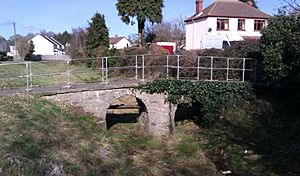Clawdd-du facts for kids
Quick facts for kids Clawdd-du Bridge |
|
|---|---|

Mediaeval bridge over the Clawdd-du
|
|
| Coordinates | 51°48′25″N 2°43′18″W / 51.8070°N 2.7217°W |
| Crosses | dry bed |
| Locale | Monmouth, Wales |
The Clawdd-du is an old defensive ditch in Monmouth, Wales. It is also known as the Black Dyke or Black Ditch. This ditch was built a long time ago, in the Middle Ages. It helped protect the area of Overmonnow, which was across the River Monnow from Monmouth Castle and the town.
Contents
Why Was the Clawdd-du Built?
The land west of the River Monnow stayed under Welsh control for a long time. This was different from the areas to the east, where the Normans built Monmouth Castle around 1067.
The area of Overmonnow was important in the Middle Ages. People there made iron and wool clothes, including special hats called Monmouth caps. Because it was so close to Welsh lands, Overmonnow could be attacked. The Clawdd-du was built to protect the people and their businesses.
How Was the Ditch Made?
Archaeologists dug up parts of the ditch in 1966. They found that it was dug in two main stages. The first part was made before the mid-1200s. The second part was dug after the mid-1300s.
The ditch stretched in a half-circle shape for about 550 meters (600 yards). It went from the River Monnow, near Chippenham Fields, then west and north towards where Drybridge House is today.
What Did the Defences Look Like?
The Clawdd-du was a wide ditch filled with water. It was about 10 to 12 meters (35 to 40 feet) wide. On the side closest to the settlement, there was a raised bank about 1.5 meters (5 feet) high. On top of this bank, there was likely a wooden fence called a palisade. It was probably possible to fill the ditch with water from the River Monnow.
A stone bridge was built across the ditch in the Middle Ages. This bridge was directly in line with Monnow Street in Monmouth and the famous Monnow Bridge over the river. It was part of the main road leading west from the town towards the village of Wonastow.
The Clawdd-du marked the edge of Overmonnow until the 1930s.
The Clawdd-du Today
Today, parts of the Clawdd-du have been filled in. However, most of it still exists as a wide ditch used for drainage. It is now a Scheduled Ancient Monument, which means it's an important historical site protected by law. The remains of the old mediaeval bridge are also a Grade II* listed building, showing its special historical value.
In 2010, local archaeologists were concerned when a trench was dug along the site without proper permission. This shows how important it is to protect this ancient landmark.

